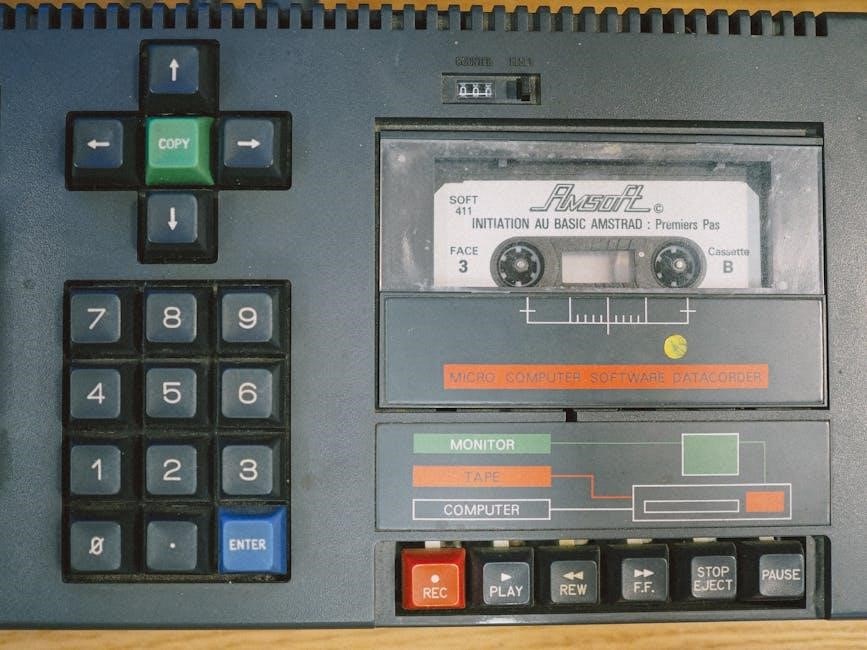Ghost Controls Keypad Manual: A Comprehensive Guide
Welcome to your comprehensive guide for the Ghost Controls keypad! This manual provides step-by-step instructions, helpful tips, and troubleshooting advice to maximize your gate opener system’s security and functionality.
Ghost Controls keypads offer a convenient and secure way to manage access to your property. These keypads eliminate the need for physical keys, providing a streamlined entry solution for family members, trusted visitors, and service personnel. Programming a Ghost Controls keypad involves setting a master PIN and adding individual access codes, ensuring that only authorized individuals can operate your gate opener system.
This manual will guide you through the process of programming, troubleshooting, and maintaining your Ghost Controls keypad. Whether you’re setting up your keypad for the first time or looking to add new access pins, this resource will provide the information you need. Keypads store multiple access pins, including a master PIN, for secure operation. Follow the instructions to ensure your system’s safety and security.

Programming Your Ghost Controls Keypad
Programming your Ghost Controls keypad is essential for secure access. This section covers creating a Master PIN and adding permanent access pins for reliable gate operation.
Creating a Master PIN
Before using your Ghost Controls keypad, you must establish a Master PIN. This PIN is crucial for all programming functions and maintaining your system’s security. The keypad stores only one Master PIN.
Steps to Create a Master PIN:
- Ensure the keypad has fresh batteries installed.
- Press the “Program” button on the keypad.
- Enter a unique 4-digit code. This will be your Master PIN.
- Press the “Send” button (or the equivalent button on your keypad version) to save the PIN.
- The keypad should provide confirmation that the Master PIN has been successfully stored.
Important Notes:
- GHOST CONTROLS recommends family members use Permanent Access Pins instead of the Master PIN for regular use.
- Keep your Master PIN secure and do not share it with unauthorized individuals.
- If you forget your Master PIN, you may need to reset the keypad to its factory settings. See the “Resetting Your Wireless Keypad” section for instructions.
Adding Permanent Access Pins
After establishing your Master PIN, you can add Permanent Access Pins for authorized users. These pins allow individuals to operate the gate opener system without needing the Master PIN, enhancing convenience and security.
Steps to Add a Permanent Access Pin:
- Press the “Program” button on the keypad.
- Enter your Master PIN.
- Press the “Send” button (or the equivalent button on your keypad version).
- Enter the desired 4-digit access code for the new Permanent Access Pin.
- Press the “Send” button again.
- The keypad should confirm that the Permanent Access Pin has been successfully added.
Important Notes:
- The keypad can store up to 19 additional access pins, including the Master PIN, up to 20 total.
- Choose unique and memorable codes for each user.
- Regularly review and update access pins as needed to maintain security.
- Inform users of their assigned access pin and instruct them on proper keypad operation;
Storing Multiple Access Pins
The Ghost Controls keypad allows you to store multiple access pins, granting different individuals access to your property without sharing the Master PIN. This feature enhances security and provides convenient access for family members, friends, or service providers.
Managing Multiple Access Pins:
- Capacity: Your keypad can store up to 19 access pins in addition to the Master PIN, up to 20 total.
- Assignment: Assign each user a unique 4-digit access pin. Avoid using easily guessable numbers like birthdates or addresses.
- Record Keeping: Maintain a secure record of assigned access pins and who they belong to. This helps with managing access and troubleshooting any issues.
- Regular Review: Periodically review the list of access pins and remove any that are no longer needed. This is especially important when someone no longer requires access to your property.
- Communication: Clearly communicate the assigned access pin and instructions for using the keypad to each authorized user.
By effectively managing multiple access pins, you can maintain a high level of security while providing convenient access for authorized individuals.

Keypad Versions and Identification
Identifying your Ghost Controls keypad version is crucial for proper programming. Different versions (V1, V2, V3) have unique programming steps. Determine your keypad version before proceeding.
Identifying Your Keypad Version (V1, V2, V3)
To ensure you follow the correct programming steps, it’s essential to identify your Ghost Controls keypad version. There are primarily three versions: V1, V2, and V3. The easiest way to distinguish between them is by looking at the “send” button.
V1 Keypad: This version typically has a black or grey “send” button. The programming process differs significantly from the other versions. Check for any version numbers on the back of the keypad.
V2 Keypad: The V2 keypad may have a slightly different button layout compared to V1. Again, the “send” button is not green on this version.
V3 Keypad: This is the most recent version and is easily identifiable by its green “send” button. The programming procedure for the V3 keypad is unique, utilizing the green “send” button for confirmation.
If you’re unsure, consult the original packaging or any included documentation for the keypad. This step is necessary.

Programming the V3 Keypad (Green Send Button)
This section details the programming procedure specifically for the V3 keypad, which features a distinctive green “send” button. Follow these steps carefully for optimal performance.
Step-by-Step Programming Guide for V3 Keypad
Programming your Ghost Controls V3 keypad (with the green send button) requires careful attention to detail. First, ensure your keypad has fresh batteries. Begin by pressing the “Program” button. Next, enter your existing Master PIN. If this is the initial setup, the default Master PIN is typically “1234”. The keypad should acknowledge the entry with a beep.
Now, to add a new access pin, press “Program” again, followed by the desired four-digit code for the new pin. Press the “Send” button (the green one) to store the new access pin. The keypad will beep to confirm successful storage. To test the new pin, enter the pin followed by the “Send” button; your gate should activate.
Remember, the V3 keypad can store multiple access pins, up to a maximum of nineteen additional pins, besides the master pin. For any further pin additions, repeat these steps. If encountering issues, consult the troubleshooting section.

Resetting Your Wireless Keypad
Resetting your Ghost Controls wireless keypad can resolve many issues. This process typically involves removing the batteries and following a specific sequence to restore factory settings.
How to Reset the Keypad
To reset your Ghost Controls keypad, begin by removing the batteries from the unit. Once the batteries are removed, press any key on the keypad once. This step discharges any residual power stored in the keypad’s memory. After pressing a key, re-insert the batteries into the keypad, ensuring they are correctly aligned according to the polarity markings inside the battery compartment.
Wait for the keypad to boot up, which usually takes less than two seconds. Once the keypad has booted up, press and release the program button. This action initiates the reset sequence. After completing these steps, your keypad should be reset to its default settings, allowing you to reprogram it with a new Master PIN and access codes.
If you encounter any issues during the reset process, consult the troubleshooting section of this manual or contact Ghost Controls customer support for further assistance.

Troubleshooting Common Issues
This section addresses common problems encountered while using your Ghost Controls keypad. If the keypad is unresponsive, first ensure the batteries are fresh and correctly installed. Low battery power is a frequent cause of malfunction. If the keypad still doesn’t respond, try resetting it by removing and reinserting the batteries, then pressing the program button.
If you’re having trouble programming the keypad, double-check that you’re following the correct sequence of steps outlined in the programming section. Ensure you’ve created a Master PIN before attempting to add other access codes. If the gate doesn’t open after entering a valid access code, verify that the keypad is properly synced with the gate opener system.
Also, confirm that the universal receiver AXUR is correctly installed and functioning. For persistent issues, consult the video tutorials available on the Ghost Controls website or contact their customer support team for personalized assistance and guidance.
Battery Management
Proper battery management ensures optimal keypad performance. Learn how to replace batteries, extend battery life, and troubleshoot battery-related issues. Regular checks can prevent unexpected access disruptions and maintain security.
Replacing the Batteries
To ensure your Ghost Controls keypad functions correctly, replacing the batteries is a crucial maintenance step. First, locate the battery compartment, generally on the back or bottom of the keypad. Open it carefully, using a screwdriver if necessary. Remove the old batteries, noting their orientation (+ and -). Insert new C batteries, matching the correct polarity as indicated inside the compartment.
Once the new batteries are in place, securely close the compartment. After replacement, test the keypad by pressing any key; it should light up. If it doesn’t, double-check the battery placement and ensure they are fresh.
If problems persist, consult the troubleshooting section. Regular battery replacement ensures uninterrupted operation, vital for your gate’s security. Remember to dispose of old batteries responsibly. For optimal performance, use high-quality alkaline batteries. This will extend the lifespan and reliability of your keypad, safeguarding your property effectively. Finally, confirm keypad functionality after the change.

Additional Features and Functions
Beyond basic gate operation, the Ghost Controls keypad boasts several additional features enhancing convenience and security; The keypad can store multiple access pins, accommodating various users like family members or service personnel, each with their unique code. Consider utilizing temporary access codes for visitors, which can be easily deleted afterwards, further bolstering security.
Many models support a “hold open” function, allowing the gate to remain open for extended periods, useful during gatherings or deliveries. Check if your keypad version includes a vacation mode, disabling gate operation while you’re away, preventing unauthorized access. Explore the option to integrate the keypad with a universal receiver, expanding compatibility with other devices.
Furthermore, some keypads offer adjustable backlight settings for improved visibility at night. Familiarize yourself with these features to fully leverage your Ghost Controls keypad’s capabilities and tailor its operation to your specific needs. Review your specific model’s manual for detailed instructions on activating and customizing these functions.

Integration with Gate Opener Systems
The Ghost Controls keypad seamlessly integrates with your gate opener system; Ensure correct wiring and programming for optimal performance. Explore compatibility with universal receivers for expanded functionality.
Using Keypad with Universal Receiver AXUR
The Ghost Controls keypad can be paired with the Universal Receiver AXUR to enhance its functionality and compatibility with various gate opener systems. This combination allows for remote gate control through the keypad, even if your gate opener is not a native Ghost Controls product.
To integrate the keypad with the AXUR receiver, you’ll need to program the receiver to recognize the keypad’s signal. Consult both the keypad manual and the AXUR receiver manual for specific programming instructions. Typically, this involves putting the AXUR receiver into programming mode and then transmitting a signal from the keypad, such as entering a valid access code.
Once programmed, the keypad will send a signal to the AXUR receiver, which in turn activates the gate opener. The AXUR receiver acts as an intermediary, translating the keypad’s signal into a command that the gate opener understands.
This setup is particularly useful for older gate openers or those from different manufacturers, allowing you to leverage the security and convenience of a Ghost Controls keypad with a wider range of systems. Remember to test the connection after programming is complete.
Safety and Security
Prioritizing safety and security is paramount when operating your Ghost Controls automatic gate opener system. The keypad plays a crucial role in maintaining the integrity of your property’s access control.
Always ensure that your Master PIN is kept confidential and is not shared with unauthorized individuals. Regularly update your access codes to prevent unauthorized entry, especially if you suspect a breach of security. Ghost Controls recommends using Permanent Access Pins for family members rather than sharing the Master PIN.
Educate all users on the proper operation of the gate and the importance of not sharing access codes with others. Emphasize the risks associated with tailgating or allowing unauthorized vehicles to enter the property.
Regularly inspect the gate and keypad for any signs of damage or malfunction. Address any issues promptly to prevent potential security vulnerabilities. Consider installing additional security measures, such as surveillance cameras, to further enhance the safety of your property. By following these guidelines, you can create a safer and more secure environment for yourself and your family.

Ghost Controls Automatic Gate Opener Manuals and Guides
This section provides a comprehensive collection of manuals and guides for Ghost Controls automatic gate opener systems. These resources offer detailed instructions, troubleshooting tips, and helpful information to ensure the optimal performance and longevity of your gate opener.
Here, you’ll find manuals specific to various Ghost Controls models, including swing gate openers, slide gate openers, and their associated accessories. These manuals cover installation procedures, programming instructions, safety guidelines, and maintenance recommendations. Additionally, quick start guides are available for users who need a concise overview of the basic setup and operation of their gate opener system.
Whether you’re a new user or an experienced operator, these manuals and guides will serve as valuable references for understanding and maintaining your Ghost Controls system. Explore the resources to find answers to your questions and learn how to maximize the benefits of your automatic gate opener. Ensure you consult the correct manual corresponding to your specific Ghost Controls model for accurate information.

Video Tutorials
Explore our video tutorials for visual guides on programming, troubleshooting, and maintaining your Ghost Controls keypad and gate opener system. Learn quickly with step-by-step demonstrations.
Programming Videos
Access a range of programming videos designed to simplify the setup of your Ghost Controls keypad. Whether you’re creating a master PIN, adding permanent access codes, or managing multiple user profiles, these videos offer clear, visual guidance. Our tutorials cover various keypad versions, including the V3 keypad with the green send button, ensuring you find the specific instructions you need.
Learn how to program your keypad step-by-step, enhancing your home’s security with ease. These videos also guide you through resetting your wireless keypad and adding additional transmitters. Watch and follow along for a seamless programming experience. Ghost Controls provides these helpful resources for automatic gate opener systems.
Maintenance and Care
Proper maintenance and care are crucial for extending the lifespan and ensuring the reliable operation of your Ghost Controls keypad. Regularly inspect the keypad for any signs of physical damage, such as cracks or loose buttons. Clean the keypad surface with a soft, damp cloth to remove dirt and debris, avoiding harsh chemicals that could damage the finish.
Pay close attention to the battery compartment, ensuring it is free from corrosion and that the batteries are securely installed. Replace the batteries as needed, following the instructions in the “Battery Management” section. Periodically test all programmed access pins to confirm they are functioning correctly.
By following these simple maintenance tips, you can keep your Ghost Controls keypad in optimal condition and enjoy years of dependable service. For automatic gate opener systems, consistent care is essential.
